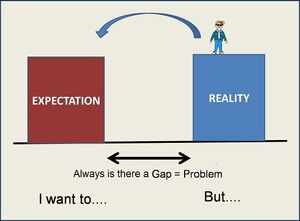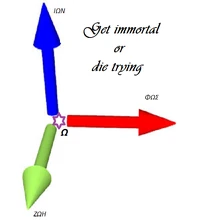Προσδοκώμενη Τιμή
Expectation value, αναμενόμενη τιμή

- Ένα μέγεθος
Ετυμολογία[]
Η ονομασία "Προσδοκώμενη" σχετίζεται ετυμολογικά με την λέξη "προσδοκία".
Εισαγωγή[]
In quantum mechanics, the expectation value is the probabilistic expected value of the result (measurement) of an experiment.
It is not the most probable value of a measurement; indeed the expectation value may have zero probability of occurring.
It is a fundamental concept in all areas of quantum physics.
Φορμαλισμός[]
In quantum theory, an experimental setup is described by the observable to be measured, and the quantum state of the system. The expectation value of in the state is denoted as .
Mathematically, is a self-adjoint operator on a Hilbert space. In the most commonly used case in quantum mechanics, is a pure state, described by a normalized[1] vector in the Hilbert space. The expectation value of in the state is defined as
(1) .
If dynamics is considered, either the vector or the operator is taken to be time-dependent, depending on whether the Schrödinger picture or Heisenberg picture is used. The evolution of the expectation value does not depend on this choice, however.
If has a complete set of eigenvectors , with eigenvalues , then (1) can be expressed as
(2) .
This expression is similar to the arithmetic mean value, and illustrates the physical meaning of the mathematical formalism: The eigenvalues are the possible outcomes of the experiment,[2] and their corresponding coefficient is the probability that this outcome will occur; it is often called the transition probability.
In quantum theory, also operators with non-discrete spectrum are in use, such as the position operator in quantum mechanics. This operator does not have eigenvalues, but has a completely continuous spectrum. In this case, the vector can be written as a complex-valued function on the spectrum of (usually the real line). For the expectation value of the position operator, one then has the formula
(4) .
A similar formula holds for the momentum operator , in systems where it has continuous spectrum.
All the above formulas are valid for pure states only. Prominently in thermodynamics, also mixed states are of importance; these are described by a positive trace-class operator , the statistical operator or density matrix. The expectation value then can be obtained as
(5) .
Υποσημειώσεις[]
Εσωτερική Αρθρογραφία[]
Βιβλιογραφία[]
Ιστογραφία[]
|
Αν και θα βρείτε εξακριβωμένες πληροφορίες "Οι πληροφορίες αυτές μπορεί πρόσφατα Πρέπει να λάβετε υπ' όψη ότι Επίσης, |
- Μην κάνετε χρήση του περιεχομένου της παρούσας εγκυκλοπαίδειας
αν διαφωνείτε με όσα αναγράφονται σε αυτήν
- Όχι, στις διαφημίσεις που περιέχουν απαράδεκτο περιεχόμενο (άσεμνες εικόνες, ροζ αγγελίες κλπ.)
















